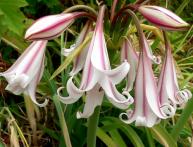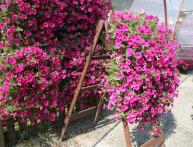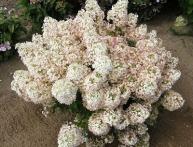Verbena: planting and care, tips for growing at home

There are plants that are not only widely distributed throughout almost the entire globe in the wild, but also widely used in floriculture. Verbena is one of these plants. In floriculture, hybrids that were originally native to South America are most often used. They are distinguished by their decorative properties and long flowering period. Let's try to find out why it's popular verbena, planting and caring for this crop in the garden.
Content:
Verbena in the garden
In floriculture, several varieties of verbena are grown and those obtained from them
forms:
- Canadian
- tough
- direct
- hybrid
Among the hybrid forms there are plants with flowers of very different colors. Beginning to bloom in early summer, verbena fades with the onset of the first frost. This is precisely why it attracts both beginners and experienced gardeners. In addition, the presence of both low-growing plants from 20 cm in height to tall ones, more than a meter in height, makes verbena a universal ornamental crop in the garden.
Most often in temperate climates, verbena is grown as annual culture. Only verbena straight can be grown as a perennial, cutting the bushes at the root in the fall.
How to grow verbena for seedlings
Soil and seeds
To guarantee the receipt of planting material, it is best to grow verbena by first obtaining seedlings.The soil for seedlings should be quite light. To do this, you can mix garden soil with an equal amount of sand. Or buy universal garden soil and mix it with perlite or sand.
To sow verbena seedlings, it is important to know that the seeds remain viable for up to five years. However, after a three-year storage period, no more than one third of verbena seeds can sprout. You can sow seeds for seedlings without special preparation, but it is still better to play it safe and prepare the seeds for planting.
Most often, preparation for sowing is carried out in two ways:
- stratification seeds
- soaking seeds in a growth stimulant solution
Stratification of verbena seeds begins approximately five days before sowing. To do this, moisten a piece of cloth well and wrap the seeds in it. All this is placed in a waterproof bag and sent to the bottom shelf or vegetable compartment of the refrigerator. After five days, the seeds can be sown. Before sowing, you can simply soak the seeds for 10 - 12 hours in warm, + 25 + 26 degrees, water. Then transfer the seeds into a stimulant solution for an hour, the drug “Bud” will do.
Video about sowing verbena and growing it:
Sowing seedlings
Sowing seedlings should not begin before the first ten days of March. You can continue it almost until the end of April. The seeds are simply spread on the surface of the soil without embedding into it. Cover the boxes with transparent film. To speed up the germination process, seedling containers should be placed in a warm place.
To do this, it is quite enough to move them to the heating radiator for 48 hours. Subsequently, the seeds are kept at + 19 + 20 degrees, regularly opening to ventilate and remove droplets of collected water. Shoots begin to appear on the 12th - 20th day.
Seedling care
Immediately after germination, seedlings need moisture. However, this can only be done by spraying them from above. It is important to avoid overwatering. When the second true leaf appears on the seedlings, verbena seating in individual pots. Two weeks after planting, the seedlings are fed with a universal mineral mixture.
Transplanting verbena into open ground
Selecting a location
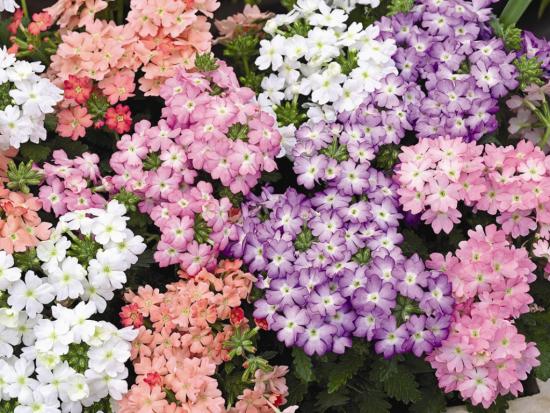
When deciding where to plant verbena in the garden, you need to remember that in general this plant is unpretentious. Of course, it will develop best in a good sunny place and on light, fertile soil without stagnant moisture. But you can plant it in almost any corner; for good health, the plant needs to be provided with drainage and removal of excess moisture. Crushed stone and expanded clay are suitable for constructing a drainage layer.
Transfer time
Verbena tolerates a short-term drop in temperature to -3 quite well, but a long-term cold snap will be detrimental for it. Therefore, verbena should be replanted at the end of May, when stable heat sets in. The selected area is dug up. For digging, add 5 kg of humus per square meter. m and a couple of tablespoons of complex fertilizers.
Before planting, you need to make holes in the prepared soil; their size should correspond to the size of the earthen ball. The distance between the holes depends on the type of verbena.
Compact species are placed at a distance of 20 cm, medium ones - at a distance of 30 cm, and large ones - at a distance of 40 - 50 cm. Before planting, the hole is spilled with water. 0.4 - 0.5 liters is enough. After this, the bush is installed and the hole is covered with earth, lightly compacting it. Immediately after planting in open ground during dry summers, verbena seedlings are regularly watered until they take root.
Caring for verbena in the garden
In the first half of summer, the plant needs regular watering. In the second half of the summer, watering is reduced. However, once every 14 days it is necessary to apply complex fertilizers to the verbena. In order for the plant to feel good during dry periods, the soil under it must be loosened regularly. This will provide air access to the roots. To prolong flowering, all old inflorescences are removed.
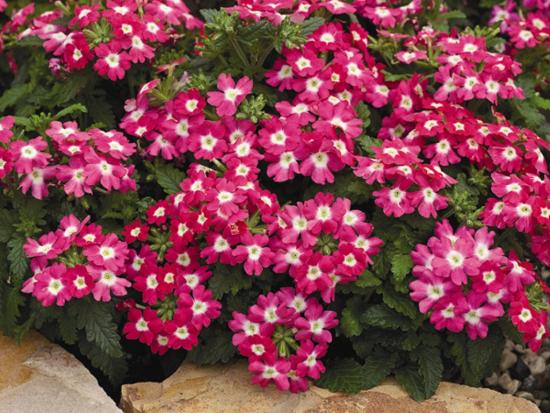
It should be said that if you dig up a verbena bush in the fall and move it to a warm place, then you can prepare from it cuttings to obtain planting material from them. In addition to decorative varieties, you can also grow verbena officinalis in the garden, which is quite widely used in folk medicine.



